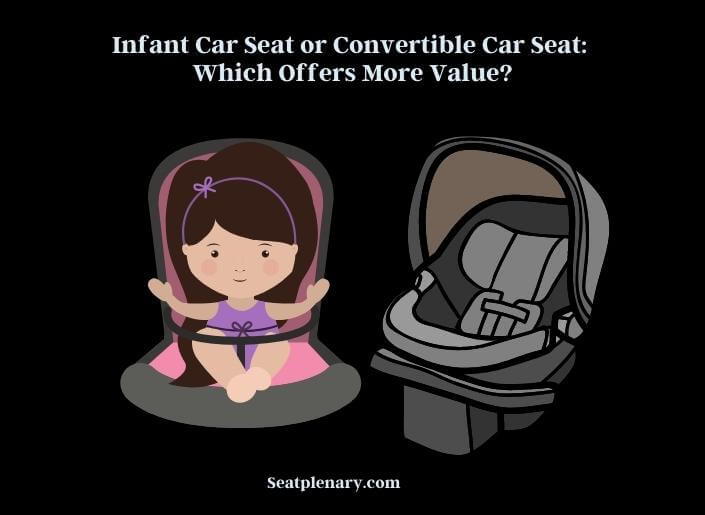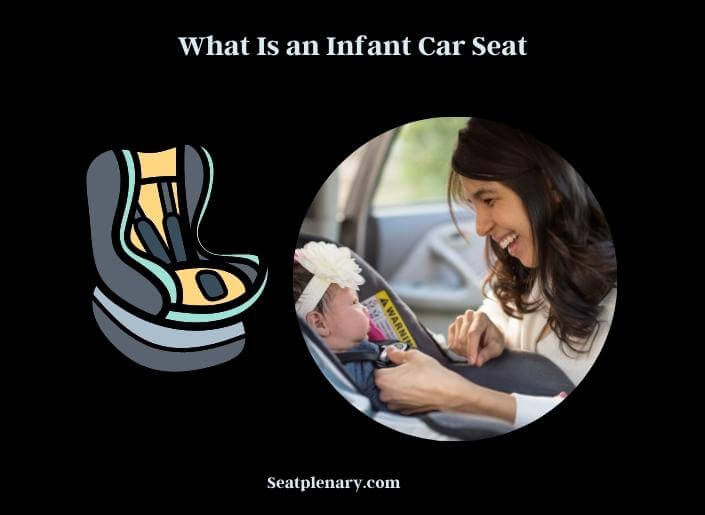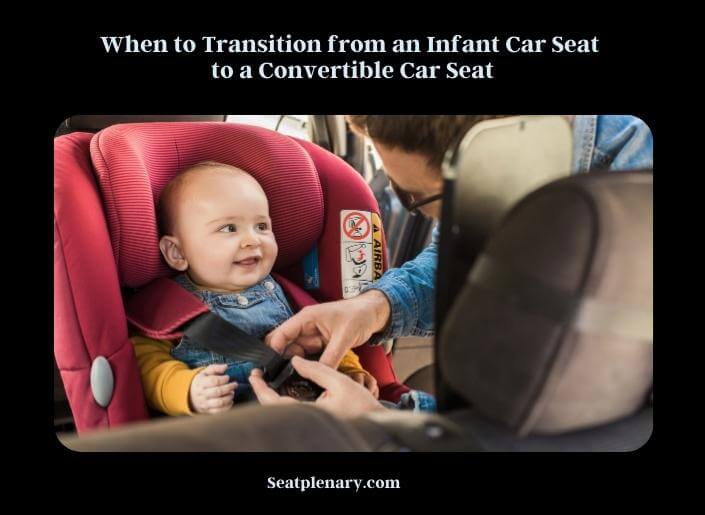When it comes to the safety of your baby, nothing is more important than choosing the right car seat. As a parent, it’s crucial to make sure your child is properly secured in a car seat that is appropriate for their age and size. Infant car seats and convertible car seats are two popular options for parents, each with its own benefits and limitations.

While infant car seats are designed for newborns and younger babies, convertible car seats can be used for a longer period of time as your child grows. Making the right choice between an infant car seat and a convertible car seat can be overwhelming, especially for first-time parents. You have to remain that it is not safe to feed a newborn in a car seat.
What Is an Infant Car Seat?
An infant car seat is a specially designed car seat that is intended for use by newborns and young babies. These car seats are designed to provide optimal safety and comfort for infants during car rides. Infant car seats are rear-facing, which means that they face the back of the car and are secured with the car’s seatbelt or a base that is installed in the car. This orientation is important because it helps to protect the baby’s head, neck, and spine in the event of a crash or sudden stop.

Infant car seats typically have a weight limit of around 22 to 35 pounds and a height limit of around 30 to 32 inches, although this can vary depending on the specific model. They are designed to fit securely and snugly around the baby’s body, with adjustable harnesses and padding to provide comfort and support. Many infant car seats also come with a handle or carrier that makes it easy to transport the baby in and out of the car, as well as a canopy or cover to shield the baby from the sun or weather.
What Is a Convertible Car Seat?
A convertible car seat is a type of car seat that can be used in both rear-facing and forward-facing positions. It’s called a “convertible” because it can be converted from a rear-facing seat for infants to a forward-facing seat for toddlers. Convertible car seats are designed to grow with your child, and typically have a higher weight limit than infant car seats, allowing them to be used for a longer period of time. They are designed to provide optimal safety and comfort for your child during car rides.
Convertible car seats can be used in the rear-facing position until your child reaches a certain weight or height limit, typically around 40 to 50 pounds or 40 to 49 inches. Once your child outgrows the rear-facing position, the seat can be converted to a forward-facing position with a harness, and used until your child is around 65 pounds or 49 to 54 inches tall. Some convertible car seats can even be converted to booster seats for older children.
Pros and Cons of Infant Car Seats
Pros
- Easy to use: Infant car seats are easy to install and remove from the car, making them convenient for parents on the go.
- Portable: Infant car seats are designed to be used outside of the car as well, so you can easily move your baby from the car to a stroller or carrier without disturbing their sleep.
- Designed for newborns: Infant car seats are designed to provide the best support and protection for newborns and young infants.
Cons
- Short lifespan: Infant car seats are only suitable for use for a short period of time, so you will need to purchase a new car seat once your baby outgrows it.
- Limited features: Infant car seats typically don’t have as many features as convertible car seats, such as cup holders or extra padding.
Pros and Cons of Convertible Car Seats
Pros
- Longer lifespan: Convertible car seats can be used from birth until your child reaches around 65 pounds, meaning you won’t need to purchase a new car seat as often.
- More features: Convertible car seats often have more features, such as cup holders or extra padding, which can make them more comfortable for your child.
Cons
- Bulkier: Convertible car seats are larger and bulkier than infant car seats, which can make them more difficult to install and remove from the car.
- Less portable: Convertible car seats are not designed to be used outside of the car, so you will need to purchase a separate carrier or stroller for your baby.
Factors to Consider When Choosing a Car Seat
When choosing between an infant car seat and a convertible car seat, there are several factors to consider.
Safety
The most important factor to consider when buying an infant car seat is safety. Look for a car seat that meets or exceeds federal safety standards. Check for any recent recalls or safety issues associated with the car seat. Some additional safety features to look for include side-impact protection, anti-rebound bars, and a five-point harness system.
Age and Size of Your Baby
Infant car seats are designed for newborns and young infants, typically weighing between 4 and 35 pounds. However, every baby is different and may outgrow an infant car seat sooner or later than others. Consider the weight and height limits of the car seat, as well as the adjustability of the straps and headrest to ensure a proper fit for your baby.
Budget
Infant car seats can range in price from around $50 to over $400. While it may be tempting to go for a cheaper option, keep in mind that the safety and quality of the car seat should be the top priority. However, there are still affordable options available that meet safety standards and have the necessary features.
Lifestyle
Consider your lifestyle when choosing an infant car seat. If you frequently travel with your baby or switch cars often, a lightweight and portable car seat may be more convenient. Some car seats are also compatible with strollers, allowing for easy transitions from car to stroller.
Ease of Use
Make sure to choose a car seat that is easy to install and use. Look for a car seat with clear instructions and straightforward installation methods. Some car seats also have features such as one-handed harness adjustment or easy buckling systems.
Brand Reputation
Do your research on the brand and model of the car seat before making a purchase. Look for reviews from other parents and check for any recalls or safety issues associated with the brand. A reputable brand with a history of producing high-quality car seats may be a safer choice.
When to Transition from an Infant Car Seat to a Convertible Car Seat?
As your baby grows, you may start to wonder when it’s time to transition from an infant car seat to a convertible car seat. While infant car seats are designed to fit babies up to a certain weight or height, convertible car seats can be used for a longer period of time, making them a more cost-effective option in the long run.

Convertible car seats are designed for babies and young children, typically ranging from newborns to toddlers up to 65 pounds. The American Academy of Pediatrics recommends that children remain rear-facing in their car seat until at least 2 years old or until they have reached the maximum weight or height allowed by the car seat manufacturer. It’s important to make sure your child still fits within the weight and height limits of the infant car seat before making the transition to a convertible car seat.
Safety is always a top priority when it comes to car seats. While infant car seats are designed to provide optimal protection for babies, convertible car seats can offer even more protection as your child grows. Look for a convertible car seat that meets or exceeds federal safety standards and has features such as side-impact protection and a five-point harness system.
Convertible car seats can be more expensive than infant car seats, but they can be used for a longer period of time, making them a more cost-effective option in the long run. Consider your budget and how much you are willing to spend on a car seat.
Consider your lifestyle when deciding whether to transition to a convertible car seat. If you frequently travel with your baby or switch cars often, a lightweight and portable convertible car seat may be more convenient. Some convertible car seats are also compatible with strollers, allowing for easy transitions from car to stroller.
Make sure to choose a convertible car seat that is easy to install and use. Look for a car seat with clear instructions and straightforward installation methods. Some convertible car seats also have features such as one-handed harness adjustment or easy buckling systems.
Final Words
Choosing the right car seat for your child is an important decision that should not be taken lightly. It’s essential to consider factors such as safety, size and weight limits, type of car seat, ease of use, comfort, and price when making your selection. Infant car seats and convertible car seats each have their own unique features and benefits, and the decision between the two ultimately depends on your specific needs and preferences.
Remember that car seat safety is critical and should always be a top priority. Make sure to read the manufacturer’s instructions carefully and install the car seat correctly to ensure maximum safety for your child. By taking the time to research and choose the right car seat, you can rest assured that your child is protected and secure during car rides.
Investing in a high-quality car seat can provide you with peace of mind and protection for your child for years to come. Take the time to weigh your options and choose the car seat that is the best fit for your child’s needs and your budget.
If you want to know about Reclining Captain’s Chairs, click here for details.
References:
